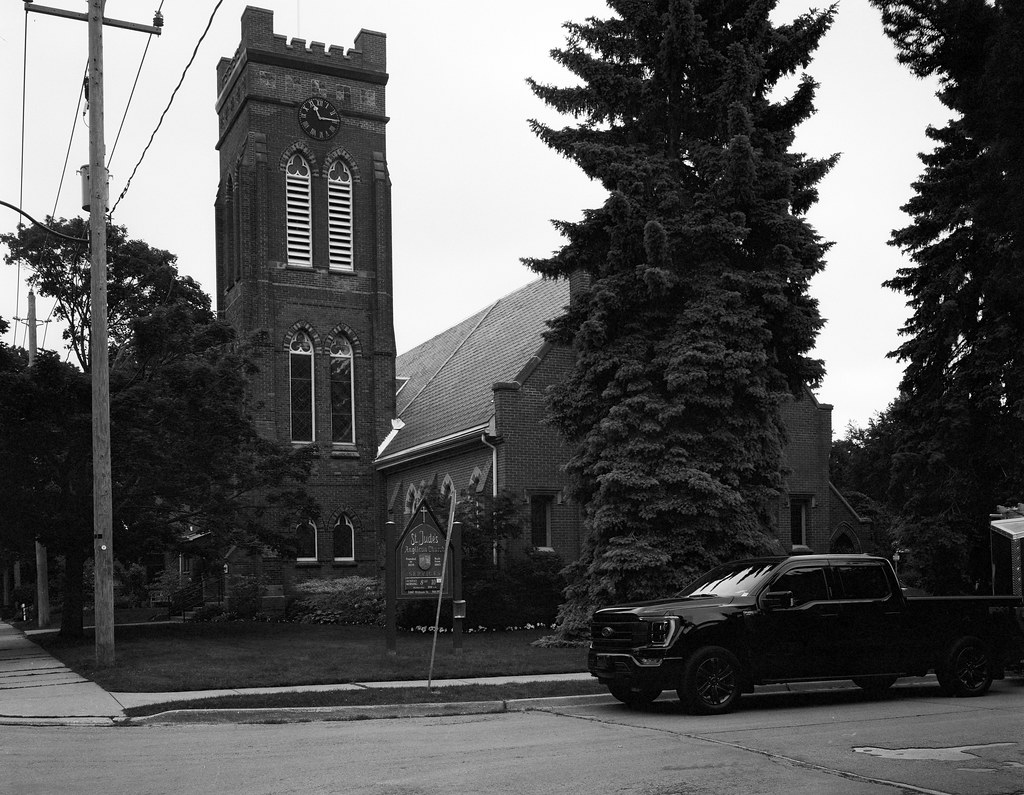The tall square bell tower of St. Jude’s Anglican Church is a landmark of Downtown Oakville; while not as prominent as Knox’s spire, the square tower reminds people that this is an Anglican church.

Despite a strong leaning towards the colonial government in Oakville, the lack of an Anglican parish in the early history of Oakville is surprising, but the Chisholms were strong Presbyterians. The first recorded Anglican service in Oakville occurred in 1839 when Rev Thomas Greene rode from Wellington Centre (Burlington) and St. Luke’s Parish to conduct a service in a local home. The strong response saw regular services being conducted in a borrow hall with a missionary preacher, usually out of St. Luke’s. It became clear that a parish could be supported in the growing village in 1841, and St. Jude’s was established. Purchasing a wooden frame church that had been recently completed at Lakeshore and Thomas when a small Wesleyan Methodist congregation could not keep up the support of the building. The simple carpenter Gothic frame church provided a home for the parish, and a dedicated Anglican cemetery was established further west on Lakeshore in 1850. But as the parish grew, the need for a larger sanctuary became apparent, and in 1870 under Rev. George Warr began raising funds to purchase a new property and build a church. Purchasing a lot in late 1870 at the corner of Thomas and Reynolds, a brick gothic revival sanctuary began taking shape in the early 1880s. The first service was held on 16 December 1883. A parish hall dedicated to the Golden Jubilee of Queen Victoria opened in 1887, and the iconic bell tower in 1896. The first organ, a manual pump instrument, was installed in 1899, built by local craftsman Robert Coates. The church would replace its gas lamps in the early 20th Century in favour of electricity, but this nearly destroyed the church. An electric furnace overheated and set the church ablaze in 1913; only through the brave efforts of the local volunteer fire brigade was the building saved. Through the interwar years, the congregation expanded not only the sanctuary by adding a new narthex at the Reynold Street frontage but added a basement and a second floor to the parish hall. The congregation also took on the role of planting new Anglican churches throughout the surrounding historic villages that would eventually become a part of Oakville. In 1968 the Casavant organ was moved to Elora and replaced by an electric organ which in turn was replaced by a fully electronic instrument in 2012. Today, St. Jude’s remains an active member of the downtown community, hosting a Montessori School and providing a memorial garden for quiet reflection.
Sometimes things don’t go right; St. Jude’s is already a complex composition, combined with location and how the sun travels. Being located along narrow residential streets makes working with a 4×5 troublesome. Add to that the day I arrived; the entire front section was blocked off by vehicles, so I had to adapt and chose only to include the bell tower as the tall evergreen tree obscures the front facade. I went with my 125mm and backed off as far as I could with that front rise to catch the tower’s entire height this time. Although even from the front, the composition would have been complex, even with a wider lens.
If you wish to worship with this congregation, they will be happy to welcome you! Please check out the congregational website for details on attending services worship either in-person on online streaming!
Web: stjudeschurch.net
Facebook: facebook.com/St-Judes-Anglican-Church-953056631412884
Instagram: instagram.com/stjudeschurchoakville